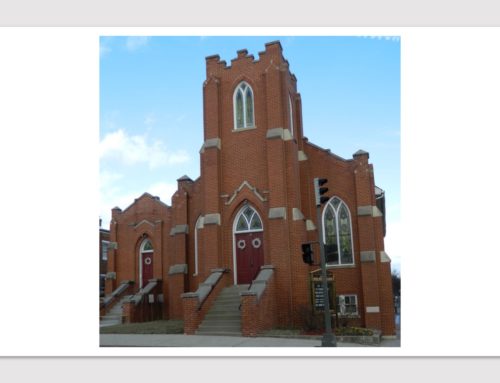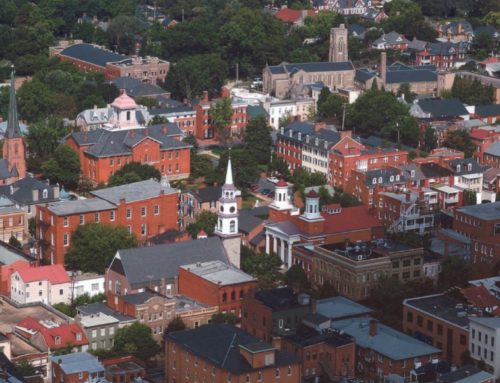Excerpt from the Frederick News-Post:
An early draft of a plan to help owners of historic properties in Frederick reap benefits from the proposed downtown hotel and conference center is floating around as part of an effort to offset the loss of the state’s last standing tannery building.
And although city officials are leery, members of the Frederick Historic Preservation Commission have thrown their full support behind it.
The multimillion-dollar, 180-room hotel and 20,000-square-foot conference center is planned for 200-212 E. Patrick St. The project is planned to come to fruition with both public and private dollars, with the lion’s share coming from the developers, Plamondon Hospitality Partners, and the remainder from the city, county and state.
As part of the project plans, the early 20th-century Birely Tannery building near Carroll Creek is set for demolition. In turn, the historic Frederick Trolley building that fronts Patrick Street and most recently served as the Frederick News-Post headquarters, is set for renovation, and incorporation into the project.
Members of several groups representing the local historic preservation community, the state, the developers, the city and other groups with interest in the project have met informally over the past several months to discuss the best and most effective way to ensure that historic elements of the site are preserved.
As part of that effort, members of Preservation Maryland — a state organization with a mission to preserve historical sites — have come up with an idea to use a portion of future revenue generated by the hotel tax for downtown historic rehabilitation. The idea was explained in a draft letter to the Department of Housing and Community Development, one of the parties involved in developing the mitigation efforts that were required as part of the tannery demolition approval.
Historic Preservation Commission Chairman Dan Lawton presented the letter Thursday to his fellow commissioners, who pledged their own support for the measure.
“Over the past five to 10 years there has been a widespread decline in financial donations from the public going to house museums and those types of organizations,” said Commissioner Carrie Albee, who also serves as president of the board of directors of the Frederick County Landmarks Commission.
“This is something that is at the forefront of my thinking, and I do think there is strong value in actually being able to earmark bricks-and-mortar monies to work on historic buildings,” she continued. “It seems to be more expensive and harder and harder to get support. … I am very pleased Preservation Maryland has put this together.”
THE LETTER
This is not the first time Preservation Maryland has taken a stance on the downtown hotel project.
Representatives publicly opposed the demolition of the tannery building before the Historic Preservation Commission voted on it.
Now in the draft letter, Preservation Maryland is proposing that a “small, to-be-negotiated percentage” of the increased hotel room tax from the new hotel project be put into a separate fund to use for loans to finance historic rehabilitation projects.
According to the letter, Preservation Maryland, the Downtown Frederick Partnership and the city of Frederick would govern the program as partners. Downtown Frederick Partnership and city officials have not agreed to govern the program. The three-way partnership is currently only an idea Preservation Maryland officials included in the letter.
The program would initially focus on facade restoration and address ongoing challenges with historic building rehabilitation, such as ADA access, sprinkler systems and second-floor reuse.
The partners would begin administering the loans once the fund hits $75,000 to $150,000, according to Preservation Maryland’s proposal, and it would be replenished annually with money from the hotel tax collected from the new project.
At Thursday’s meeting, the city’s Historic Preservation Commission voted unanimously to draft its own letter of support for Preservation Maryland’s idea.
But the implementation may not be quite that easy.
PLAN IN THE WORKS
Matt Davis, the city’s manager of comprehensive planning, told commissioners Thursday that a draft memorandum of understanding that will map out the details of the mitigation plan is already circulating. The MOU will be signed by city officials, the developers, the Maryland Historical Trust and the Department of Housing and Community Development. Davis said he does not believe Preservation Maryland’s plan will be included in that document.
“It’s really not mitigation for what’s being lost,” Davis said in the meeting.
He also said no mechanism currently exists to implement that type of program.
“It’s a little more involved than just all of a sudden money coming to a certain entity and then how you distribute that and administer that program. It’s something that will take a lot of discussion,” Davis said. “Not to say something like this can’t exist within the city, but this might not be the exact place for that to occur.”
Albee disagreed.
“This is, in fact, a perfect example of creative mitigation,” she said. “We’ve already talked about the unusual importance of the tannery site and the legislation that calls for this consultation to consider effects on historic properties. That absolutely allows for, enables and encourages creative uses of monies that will ultimately go to mitigation, and particular monies that will benefit the public actively.”
HOTEL TAXES
AND THE DOWNTOWN HOTEL PROJECT
Frederick County collects hotel tax revenue, with about 97 percent of the funds passed through the Tourism Council of Frederick County.
In August 2016, the Frederick County Council narrowly voted to raise the tax rate from 3 percent to 5 percent. With that approval, a plan from the Tourism Council to divert a portion of the revenue to a downtown hotel incentive program was also approved. The program allows the proposed downtown hotel and conference center to get back up to 85 percent of the hotel rental tax it pays. The stipulation was included in a memorandum of understanding that took effect with the council’s vote to increase the tax.
Tourism Council Executive Director John Fieseler explained that the tax money the hotel is receiving back is set to be used for public infrastructure costs the city is slated to contribute toward the project. In turn, he said, the only way a portion of the hotel tax could be used for something else — such as the proposed loan program for historic rehabilitation efforts — would be if it came out of those funds.
“It would be up to the city if they wanted to take a portion they were counting on to service part of the parking structure [to go toward Preservation Maryland’s proposal],” Fieseler said.
He added that he has not seen the draft letter from Preservation Maryland, but is familiar with the idea.
Frederick Economic Development Director Richard Griffin said he is also familiar with the the idea because it was discussed during the recent informal meetings. He said he has not seen the letter from Preservation Maryland but anticipates its contents, and the position of the Historic Preservation Commission, will be taken into consideration.
“Anybody that has an idea should submit it,” he said. “We are going to take the recommendations, look at the impact from the demolition, and come up with mitigation strategies.”
He confirmed that a draft MOU is in the works and circulating. He would not comment on any information that is or is not in the document, though.
“As soon as the signatory partners have agreed on the content, it will be made public and subject to a public workshop,” he said.
This story has been updated to clarify that Downtown Frederick Partnership and city officials have not agreed govern the potential program with Preservation Maryland.



